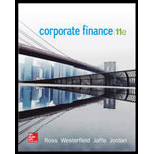
Corporate Finance (The Mcgraw-hill/Irwin Series in Finance, Insurance, and Real Estate)
11th Edition
ISBN: 9780077861759
Author: Stephen A. Ross Franco Modigliani Professor of Financial Economics Professor, Randolph W Westerfield Robert R. Dockson Deans Chair in Bus. Admin., Jeffrey Jaffe, Bradford D Jordan Professor
Publisher: McGraw-Hill Education
expand_more
expand_more
format_list_bulleted
Question
Chapter 29, Problem 4CQ
Summary Introduction
To explain: The reasons to split off a division of a company and to identify any possibility of reverse synergy.
Synergy:
Synergy is a state in which two or more companies combined together to perform better than the sum of their individual efforts in terms of productivity, revenue, and so on.
Spilt Off:
Spilt off is a corporate strategy of creating a value by separating the corporate assets. It is restructuring an existing corporate structure in which shares of the subsidiary company is transferred to the shareholders of the parent company in lieu of the stock of the parent company.
Expert Solution & Answer
Want to see the full answer?
Check out a sample textbook solution
Students have asked these similar questions
What is the amount of budget that could be provided using these advertisements?
(not specific, can be general amount in peso):
• Television Commercial
• Radio
• In-store/banner/billboards
• Publication Materials for Facebook and Instagram
• Reels/TikTok Videos
• GIF
• Marathon
• Campus Caravan
• E-Vouchers
• Deals Offer
Please cite references.
What is a blue-chip stock?
a) A stock with high volatilityb) A stock of a well-established, financially sound companyc) A newly launched IPO stockd) A stock with high dividends but low growth no ai
What is a blue-chip stock?
a) A stock with high volatilityb) A stock of a well-established, financially sound companyc) A newly launched IPO stockd) A stock with high dividends but low growth
need help!
Chapter 29 Solutions
Corporate Finance (The Mcgraw-hill/Irwin Series in Finance, Insurance, and Real Estate)
Ch. 29 - Prob. 1CQCh. 29 - Prob. 2CQCh. 29 - Prob. 3CQCh. 29 - Prob. 4CQCh. 29 - Prob. 5CQCh. 29 - Prob. 6CQCh. 29 - Economies of Scale What does it mean to say that a...Ch. 29 - Prob. 8CQCh. 29 - Prob. 9CQCh. 29 - Prob. 10CQ
Ch. 29 - Prob. 1QPCh. 29 - Prob. 2QPCh. 29 - Prob. 3QPCh. 29 - Prob. 4QPCh. 29 - Cash versus Stock Payment Penn Corp. is analyzing...Ch. 29 - EPS, PE, and Mergers The shareholders of Flannery...Ch. 29 - Prob. 7QPCh. 29 - Cash versus Stock as Payment Consider the...Ch. 29 - Prob. 9QPCh. 29 - Prob. 10QPCh. 29 - Prob. 11QPCh. 29 - Prob. 12QPCh. 29 - Prob. 13QPCh. 29 - Prob. 14QPCh. 29 - Prob. 15QPCh. 29 - Prob. 16QPCh. 29 - Prob. 1MCCh. 29 - Prob. 2MCCh. 29 - Prob. 3MCCh. 29 - Prob. 4MC
Knowledge Booster
Similar questions
- What is a blue-chip stock? a) A stock with high volatilityb) A stock of a well-established, financially sound companyc) A newly launched IPO stockd) A stock with high dividends but low growtharrow_forwardNeed help in this question !properly What does “liquidity” refer to in finance? a) The profitability of a companyb) The ease of converting assets into cashc) The stability of incomed) The level of debtarrow_forwardI need help in this question! What does “liquidity” refer to in finance? a) The profitability of a companyb) The ease of converting assets into cashc) The stability of incomed) The level of debtarrow_forward
- Dont use chatgpt and give answer What does “liquidity” refer to in finance? a) The profitability of a companyb) The ease of converting assets into cashc) The stability of incomed) The level of debtarrow_forwardThe opportunity cost of holding cash is inversely related to the level of market interest rates. Question 9 options: True Falsearrow_forwardYour firm deals strictly with four customers. The average amount that each customer pays per month along with the collection delay associated with each payment is shown below. Given this information, what is the amount of the average daily receipts? Assume that every month has 30 days. Customer Item Amount Delay A $8,500 5 days B $12,000 2 days C $16,000 3 days D $3,600 2 days Question 8 options: $8,448 $1,337 $3,342 $1,408 $10,025arrow_forward
- Which of the following is true regarding cash management? Question 7 options: The basic objective in cash management is to keep the investment in cash as low as possible while still operating efficiently and effectively. Effective cash management results in minimization of the total interest earnings involved with holding cash. A cost of holding cash is the liquidity it gives the firm. A firm should decrease its cash holdings as long as the NPV of doing so is negative. A cost of holding cash is the interest income earned on the outstanding cash balance.arrow_forwardLow default risk is a characteristic of money market securities. Question 6 options: True Falsearrow_forwardJeep Corp. held large sums of cash during the mid-1990s primarily because it would need a large amount of cash in the event of a recession. This is a[n] _____ for holding cash. Question 5 options: Adjustment motive. Compensating balances motive. Speculative motive. Transactions motive. Precautionary motive.arrow_forward
- With respect to the workings of a lockbox system, the cheque clearing process begins before the company even knows the payments have been received. Question 4 options: True Falsearrow_forwardYou are considering implementing a lockbox system for your firm. The system is expected to reduce the collection time by 1.5 days. On an average day, your firm receives 250 checks with an average value of $400 each. The daily interest rate on Treasury bills is .02%. What is the anticipated amount of the daily savings if this system is implemented? Question 3 options: $30 $25 $15 $20 $10arrow_forwardDisbursement float is virtually eliminated when payments are made electronically. Question 2 options: True Falsearrow_forward
arrow_back_ios
SEE MORE QUESTIONS
arrow_forward_ios
Recommended textbooks for you



